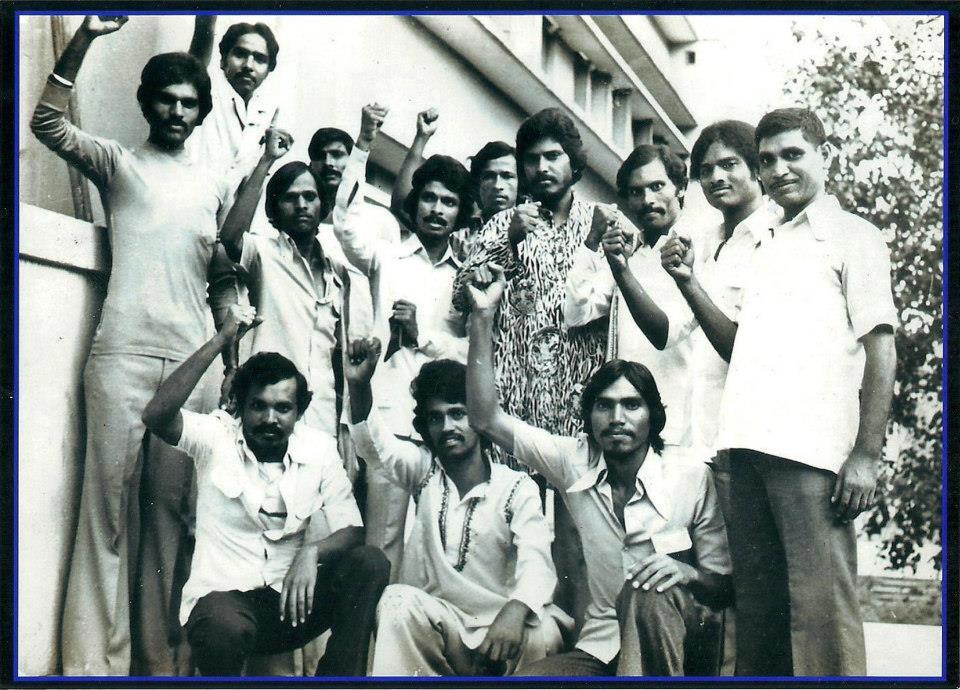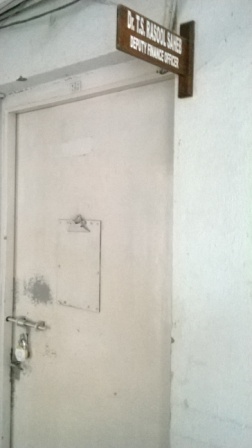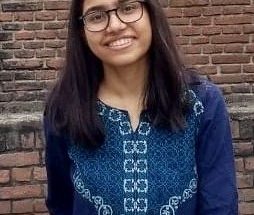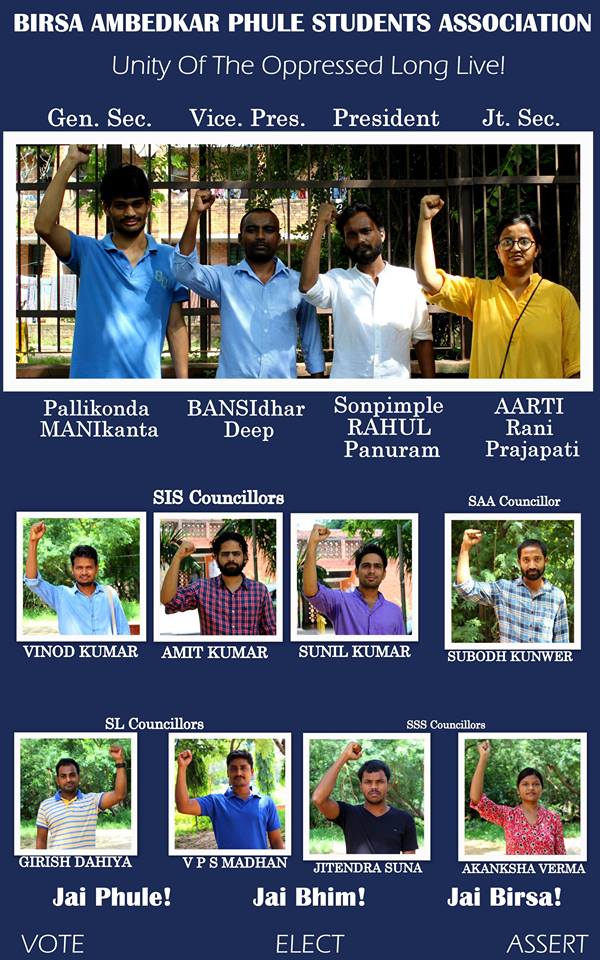Karuppan1
I
On December 6, 2016, I stood at the heart of Shivaji Park in Dadar. Walking in the narrow passages between a couple of hundred stalls selling literature and memorabilia, the banner hanging in front of one, unsettled me. ‘Delete the Dalit’, it cried out, at the thousands that streamed past it. Over the course of that year, a few friends and I had interviewed founders of the Dalit Panther with the intention of making a series of short films set around the organisation. We decided to go to Mahaparinirvan Diwas to talk to people about the Dalit Panther Project. People had varied responses to the Project. Some expressed satisfaction at our efforts, others lamented the failures of Ambedkarite leaders.

One interaction that made an impression on me, was with a middle-aged man, dressed in formal attire as if he had dropped in on his way to a corporate office. “Why Dalit Panther Project?” he enquired. Unsure what his grievance was with the term Dalit, we informed him that ours was merely a documentation project, and we found no reason to change the name of the Dalit Panther forty odd years after it had been established. Unperturbed, our new friend proceeded to inform us that the term Dalit had been declared ‘unconstitutional’, allegedly by the Supreme Court. He also felt we discovered, that the term Dalit had a negative connotation, suggesting a sense of inferiority, and should, therefore, be discarded immediately. To his mind, the ideal alternative was Bahujan.
His monologue lasted only fifteen minutes, but some of the questions raised by him lingered in my mind long after. I recalled the stark headline of a newspaper article by a legal scholar, Sumit Baudh, ‘I am Dalit, not SC’2. This article is from the time that saw the vigorous contestation over Rohith Vemula’s status as a member of the Scheduled Castes. Sumit argued eloquently that the legal status of ‘Scheduled Caste’ fails to capture the lived experiences of Dalits, as it is ‘nothing more than legal nomenclature and it decides whether or not we avail reservations, and whether or not we avail protection under legislation like the Scheduled Castes and the Scheduled Tribes (Prevention of Atrocities) Act, 1989’. Dalit status is more than SC status, he concluded; ‘I am Dalit, and I choose not to avail SC reservations’. I was moved by this articulation, because to me, it invoked the raging struggle for dignity that had been unleashed in Maharashtra, over fifty years ago. On the other hand, the conversation at Shivaji Park left me confused. What had happened in the Ambedkarite movement that could lead to such a gulf between the man who demanded to be called Bahujan, and Sumit, who self-identifies as Dalit?
II
In an effort to reconcile this dichotomy, I decided to find out more about the debate surrounding the term Dalit. As a lawyer, my first instinct was to locate this supposed decision of the Supreme Court.
One of the founding members of the Dalit Panthers, and noted Ambedkarite intellectual Raja Dhale, in a speech at Bhandara in January 2013, highlighted a reader’s letter written to the Marathi newspaper Loksatta in May, 20113. This reader draws the newspaper’s attention to a report in ‘an English newspaper’, published between April and May 2011, where the Supreme Court upheld a decision of the Madurai Sessions Court, and supposedly held that calling someone a Dalit constitutes an offence under the SC/ST (Prevention of Atrocities) Act, 1989. This is probably a reference to the decision of the Supreme Court in Arumugam Servai and Ors. v. State of Tamil Nadu4, heard on appeal from the order of the Madras High Court upholding the judgment of the Madurai Sessions Court. In this case, following an altercation between certain members of the Pallan caste (Scheduled Caste) and Servai caste (Backward Caste) over the method of tying bullocks in jallikattu. As a result, Arumugam Servai attacked the victim, Panneerselvam, saying ‘you are a pallapayal and eating dead cow beef'(sic). Amongst other things, it was this act of referring to Panneerselvam by his caste name as a pejorative, that was held to constitute an offence under the Atrocities Act. The judgment does not contain any reference to the word Dalit.
In another instance, I came across an order of the National Commission for Scheduled Castes, instructing government departments to refrain from using the term Dalit in their documents, because, when contrasted with the phrase ‘Scheduled Caste’, the term Dalit has no basis in law5. On the face of it, there can be little argument about this. The state machinery has no business using the word Dalit to refer to members of the Scheduled Castes. Having said that, one cannot see how the order can be used as the basis for exhorting people within the movement to stop using the word themselves.
Then came Pankaj Meshram v. Jt. Secretary, Ministry of Information and Broadcasting and Ors.,6 a PIL filed before the Nagpur Bench of the Bombay High Court. In a TwoCircles report, Meshram, general secretary of an Amravati based organisation named Bhimshakti, expressed the opinion that the term Dalit is hurtful to Bahujans, and social media is ‘spreading the word intentionally to takedown Bahujans’7. This report also cites a Ph.D. student who asserts that Dr. Ambedkar had ‘opposed the word Dalit in front of Ramsay Macdonald in 1935′. I have since been scouring the minutes of discussions at the Round Table Conference, but have found nothing. It would truly be a great asset if this Ph.D. student were to share with us the minutes of this meeting, rare as such documents tend to be. As far as the Pankaj Meshram PIL is concerned, the High Court website suggests that no final order has been passed as on date in the matter.
In using the legal route to wipe a word out of existence, Mr. Meshram is in company with the likes of smooth operators such as the Government of Maharashtra. In 1963, the state government passed the Maharashtra Deletion of Term “Famine” (From Laws Applicable to the State) Act, of which, Section 3(2) allowed the government to delete the term ‘famine’ from all state laws, and substitute it, where necessary, with the term ‘scarcity’. The rationale behind this was that ‘whereas the agricultural situation in the state is constantly watched by the State Government and relief measures…are provided as soon as signs of scarcity conditions are apparent…there is now no scope for famine conditions to develop’. Consequently, the government of Maharashtra ensured that there would never occur another famine in the state after the year 1963. Journalist P. Sainath suggests that the government could take its logic one step further, and address the farmer suicide crisis in Maharashtra by redefining ‘farmer’, and then, ‘suicide’8.
Having gone through these judgments and orders, I was disappointed by the casual and uninformed arguments that I heard on December 6 by this man. The 2011 national census numbers suggest that 2.75% of members of the Scheduled Castes have achieved graduate level educational status9. It is important to understand that in a community where less than 3% of its total population has completed college, the importance of proper political education, based on facts and research, it cannot be stated enough. Equipped with the correct information, its political mobilisation may have great potential. Equally, those who spread misinformation and rumours do our people great harm. I would be happy if facts unknown to me were brought forward, for I would learn from them. This tendency to misquote judgments or government orders would be laughable were it not for the fact that such individuals exploit the illiteracy of our people to benefit their political motivations. The issue is not only whether the term Dalit should be left behind, but also of the manner in which we should arrive at this decision. There are certain matters that ought to be litigated in the peoples’ courts, not that of the law, and especially not with patent falsehoods. I wonder how many people believed the story narrated by our Dalit-deleting friend, and whether they were acquainted with the rich and varied history of the term within the Ambedkarite movement.
III
The Dalit Panther Manifesto, published by Namdeo Dhasal in 1973 (then the Defence Minister of the organisation), defined Dalit as including ‘members of the scheduled castes and tribes, Neo-Buddhists, the working people, landless and poor peasants, women, and all those who are being exploited politically, economically and in the name of religion’10. Initially, it was this universalist vision enshrined in the document that drew our attention to the Panthers. But the word has a long history. Dalit, meaning ‘broken to pieces’ or ‘ground down’11, was already in use during the 1930s, as the Marathi equivalent of the English legal classification, ‘Depressed Classes’. Dr. Ambedkar uses a related English phrase, ‘Broken Men’, in his essay ‘Untouchables – Who Were They and Why They Became Untouchables'(1948).
In the years following the death of Dr. Ambedkar, Dalit was increasingly taken up as a term of self-identification by members of the Scheduled Castes, as opposed to the term Harijan, which was conferred upon the members of the untouchable castes by sympathetic caste Hindu reformers. Illustrative of this was how Manohar Raut, a Panther activist in Nagpur, recounted in a recent interview with us, that the word Harijan was used as a pejorative to refer to members of the Scheduled Castes who chose to join the Congress or work at cross purposes with the Ambedkarite movement.
Maharashtra in the 1960s witnessed the advent of a new generation of writers, who brought into the written word their lived experiences of caste, hunger, poverty, and unemployment. Baburao Bagul, a pioneering writer in this decade, said ‘that literature which celebrates the liberation of man, that which exalts man, that which strictly opposes varna, jati, and superiority, is Dalit literature’12.
Such was the significance of the term Dalit. It was not a symbol of subjugation, but a proclamation of the essential humanity of all people. Liberated by the abolition of untouchability in the Constitution of India, a generation of young Indians embraced the term in an act of defiance. The Little Magazine movement bore witness to the agony of a people who had hitherto gone unrecorded in the cultural sphere. The seething anger against an unjust world that this literature recorded, took its next step when some of its finest contributors such as Namdeo Dhasal, J.V. Pawar and Raja Dhale went on to create the Dalit Panthers.
This is not to say that there is a consensus on the use of the word within the movement. Recently, a senior Dalit Panther leader told us in an interview that while he had no problem with the term Dalit by itself, he did take issue with the expansion of its scope, and the attempt to make it universalist. To him, this took away from the focus on what he said was the Ambedkarite movement’s primary goal, that of the annihilation of caste, and brought it closer to a Marxist, class-based analysis of society. There exists another line of thought which suggests that the term has lost the militancy inherent in its early years. Hugo Gorringe points out that ‘according to Thirumavalavan (leader of the VCK (Liberation Panthers) of Tamil Nadu), the attempt to escape the Dalit tag occurred for three reasons; one (of which) being that ‘everyone is now using the term Dalit, and so it is seen to have lost the radicalism that was associated with it and has become an ascribed rather than a chosen epithet’13. To sum up, while at one point the term was used by members of the community to refer to themselves, it lost its edge when those outside the Dalit fold also started using the term.
In a movement with its foundations in the spirit of education and independent enquiry, the debate around the use of the term Dalit commenced soon after Dr. Ambedkar’s conversion to Buddhism. Respected academic Gail Omvedt notes that there are those, including particularly, Buddhists, who feel that the word is not appropriate anymore, and they have moved to a space where they want a positive identity14.
Yashwant Manohar, a noted Ambedkarite poet, argues that the opposition to the term Dalit Sahitya commenced in 1960, by literary persons like T.P. Adsul and Raja Dhale15. He raises the concern that not all Dalit writers were Ambedkarite in spirit, because some of them are opposed to Dr. Ambedkar’s demand for conversion, and had refrained from converting to Buddhism themselves. This led to the challenge of reconciling the ideological differences between some Dalit writers that were Buddhists and others that weren’t. He also points out that Dalit refers to a social grouping, and some writers wished to identify themselves with their aspirations and worldview, which were decidedly Ambedkarite. While these concerns are valid, they fail to address the possibility of Buddhist writers straying away from the Ambedkarite spirit. Raja Dhale, in his speech as chairperson of the Maharashtra Bouddha Sahitya Parishad in 1976 touched upon this, when he stated ‘there are those on the platform of Dalit literature, who oppose Ambedkarite inspiration, and there can also be some on the platform of Bouddha literature that are out to harm Ambedkarite inspiration’16. In that address, he proposed that both the phrases – Dalit writers and Buddhist writers – must be discarded. Instead, all participants of this intellectual movement should be referred to as writers of Ambedkarite inspiration. In subsequent decades, he has further developed his position and argued that this ideological stream should be referred to as Phule-Ambedkarite. These are but glimpses of the vibrant debate that has existed in Maharashtra at every stage of development of the movement.
IV
It is clear by now that there are certain sections within the Ambedkarite movement which earnestly hope that the word Dalit will be discarded in the time to come, not just by caste Hindus, but by members of the Scheduled Castes. A popular alternative appears to be Bahujan as suggested by our friend on December 6th. In my opinion, this is unviable. A recent article in Loksatta17, points out that the Bahujan concept (as it is typically used today) does not oppose Hindutva, as it includes within its scope many Hindu communities or at least such identities that aren’t opposed to Hinduism. Its primary purpose is to bring together voters from the Scheduled Caste and OBC communities. Such is the tragedy of Indian electoral politics that Scheduled Caste candidates have to seek votes from the very communities that inflict caste violence upon them. This categorisation has no place in the Ambedkarite worldview, one that is committed to the annihilation of caste and predicated upon exiting the Hindu religion.
To me, the question is not whether the epithet Bahujan should be used as an alternative to Dalit. The issue at hand is whether the term Dalit needs to be replaced at all, and how we should collectively arrive at this conclusion in a movement with strong intellectual roots such as ours.
The terms we employ in the articulation of our political struggles are merely tools, and it is unreasonable to demand that the tools shouldn’t evolve with time. But we shouldn’t lose sight of the fact that there are words which carry great significance, and have the power to shape narratives and movements. It makes sense when the powers that be, threatened by the strength of particular words, seek to write them out of existence. Is it right to do the same to the term Dalit, under whose shadow was wrought some of the greatest social struggles? This is a word nurtured by the people, imbued with an ocean of meaning by them. It anchored their challenge to the establishment in the years in which no towering leader existed for the masses to rally around.
I have tried to highlight the fact that there already exists a rich, nuanced body of writing on this question. The contributors to this debate have been the leading thinkers of the Ambedkarite movement in Maharashtra. Some of them are academics, while others have shaped the course of our struggle through their writing as well as political actions. A significant challenge in the dissemination of their thought has been the unavailability of translations of their writings in different languages. I have often wondered how different the trajectory of the Ambedkarite movement in India could have been if the questions raised and answers found by our previous generations had been easily accessible to all of us. Rather than quibble over the erasure of words, some of our zealous activists could have engaged more constructively in the struggle for the annihilation of caste, who knows? In the end, what the Ambedkarite movement needs to eradicate is Dalitatva. Dalit-hood. Only then, perhaps, we could consign Dalit to the pages of history.
~
Notes
1. This article originally appeared in the first issue of the student magazine, Savitri, published by the Savitri Phule Ambedkar Caravan study circle of NLSIU, Bangalore, in January, 2018.
2. S. Baudh, I am Dalit, not SC, INDIAN EXPRESS (October 6, 2016) http://indianexpress.com/article/opinion/columns/rohith-vemula-Dalit-scheduled-caste-treatment-suicide-opinion-2998129/, last accessed on July 20, 2017.
3. Raja Dhale, SPEECHES ABOUT LITERATURE (2013, pp. 26-27, translated by author).
4. Arumugam Servai and Ors. v. State of Tamil Nadu, Supreme Court of India, (Criminal Appeal 958 of 2011, Markandey Katju, Gyan Sudha Mishra, JJ.).
5. Press Trust of India, Dalit Word is Unconstitutional: Scheduled Caste Commission, TIMES OF INDIA (January 18, 2008) available at http://timesofindia.indiatimes.com/india/Dalit-word-is-unconstitutional-Scheduled-Caste-Commission/articleshow/2710993.cms, last accessed on July 20, 2017.
6. Pankaj s/o Leeladhar @ LalitjiMeshram v. Jt. Secretary, Ministry of Information and Broadcasting and Ors., High Court of Bombay (Nagpur Bench) (PIL/114/2016).
7. Shiva Thorat, Clarity or Confusion: The Word ‘Dalit’ has become a playground, TWOCIRCLES, (August 30, 2016), available at http://twocircles.net/2016aug30/1472558065.html, last accessed on July 20, 2017.
8. P. Sainath, Food Security – By Definition, THE HINDU (August 20, 2010) available at http://www.thehindu.com/opinion/columns/sainath/Food-security-mdash-by-definition/article16151834.ecelast accessed on July 20, 2017.
9. Office of the Registrar General & Census Commissioner, India, Educational Level by Age and Sex for Population Age 7 and Above, available at http://www.censusindia.gov.in/2011census/C-series/C08.html – last accessed on July 20, 2017.
10. Namdeo Dhasal, DALIT PANTHER MANIFESTO (1973) available at http://shodhganga.inflibnet.ac.in/bitstream/10603/14528/15/15_appendicies.pdf – last visited on July 20, 2017.
11. Anupama Rao, Representing Dalit Selfhood, INDIA SEMINAR, available at http://www.india-seminar.com/2006/558/558%20anupama%20rao.htm – last accessed on July 20, 2017.
12. Dr. Sunil Chandanshive, MARATHI DALIT KAVITA: A CRITICAL STUDY (2005, p.50, translated by author).
13. Hugo Gorringe, UNTOUCHABLE CITIZENS: DALIT MOVEMENTS AND DEMOCRATIZATION IN TAMIL NADU (2005, p. 65).
14. Gail Omvedt, Dalit or Scheduled Caste: A Terminological Choice, SEEKING BEGUMPURA (July 8, 2012) available at https://seekingbegumpura.wordpress.com/2012/07/08/Dalit-or-scheduled-caste-a-terminological-choice/last accessed on July 20, 2017.
15. Yashwant Manohar, Marathi Dalit Sahitya Aani Ambedkarvad, BHARTIYA DALIT SAHITYA, (2013, p. 64, translated by author).
16. Raja Dhale, RAJA DHALE: SAMAGRA LEKHAN (2016, Vol. 1, p 159, translated by author).
17. Madhukar Kamble, Ambedkari Rajkaranatil Fasva Bahujanwad, LOKSATTA (April 16, 2017) available at http://www.loksatta.com/vishesh-news/dr-babasaheb-ambedkars-politics-bjp-narendra-modi-hinduism-1453889/last accessed on July 20, 2017.
~~~
Karuppan is a Tamil Dalit, an alumnus of NLSIU, Bangalore, who practices in Maharastra. Over the years, he has been committed to the idea of reviving and strengthening Dalit culture production, as well as engaging in a critical study of the Ambedkarite movement’s history, post-Ambedkar.










